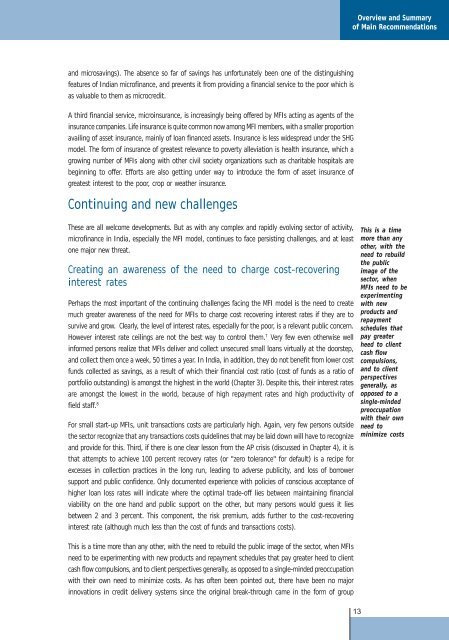Download sector_report1.pdf - Microfinance and Development ...
Download sector_report1.pdf - Microfinance and Development ...
Download sector_report1.pdf - Microfinance and Development ...
You also want an ePaper? Increase the reach of your titles
YUMPU automatically turns print PDFs into web optimized ePapers that Google loves.
Overview <strong>and</strong> Summary<br />
of Main Recommendations<br />
<strong>and</strong> microsavings). The absence so far of savings has unfortunately been one of the distinguishing<br />
features of Indian microfinance, <strong>and</strong> prevents it from providing a financial service to the poor which is<br />
as valuable to them as microcredit.<br />
A third financial service, microinsurance, is increasingly being offered by MFIs acting as agents of the<br />
insurance companies. Life insurance is quite common now among MFI members, with a smaller proportion<br />
availing of asset insurance, mainly of loan financed assets. Insurance is less widespread under the SHG<br />
model. The form of insurance of greatest relevance to poverty alleviation is health insurance, which a<br />
growing number of MFIs along with other civil society organizations such as charitable hospitals are<br />
beginning to offer. Efforts are also getting under way to introduce the form of asset insurance of<br />
greatest interest to the poor, crop or weather insurance.<br />
Continuing <strong>and</strong> new challenges<br />
These are all welcome developments. But as with any complex <strong>and</strong> rapidly evolving <strong>sector</strong> of activity,<br />
microfinance in India, especially the MFI model, continues to face persisting challenges, <strong>and</strong> at least<br />
one major new threat.<br />
Creating an awareness of the need to charge cost-recovering<br />
interest rates<br />
Perhaps the most important of the continuing challenges facing the MFI model is the need to create<br />
much greater awareness of the need for MFIs to charge cost recovering interest rates if they are to<br />
survive <strong>and</strong> grow. Clearly, the level of interest rates, especially for the poor, is a relevant public concern.<br />
However interest rate ceilings are not the best way to control them. 7 Very few even otherwise well<br />
informed persons realize that MFIs deliver <strong>and</strong> collect unsecured small loans virtually at the doorstep,<br />
<strong>and</strong> collect them once a week, 50 times a year. In India, in addition, they do not benefit from lower cost<br />
funds collected as savings, as a result of which their financial cost ratio (cost of funds as a ratio of<br />
portfolio outst<strong>and</strong>ing) is amongst the highest in the world (Chapter 3). Despite this, their interest rates<br />
are amongst the lowest in the world, because of high repayment rates <strong>and</strong> high productivity of<br />
field staff. 8<br />
For small start-up MFIs, unit transactions costs are particularly high. Again, very few persons outside<br />
the <strong>sector</strong> recognize that any transactions costs quidelines that may be laid down will have to recognize<br />
<strong>and</strong> provide for this. Third, if there is one clear lesson from the AP crisis (discussed in Chapter 4), it is<br />
that attempts to achieve 100 percent recovery rates (or "zero tolerance" for default) is a recipe for<br />
excesses in collection practices in the long run, leading to adverse publicity, <strong>and</strong> loss of borrower<br />
support <strong>and</strong> public confidence. Only documented experience with policies of conscious acceptance of<br />
higher loan loss rates will indicate where the optimal trade-off lies between maintaining financial<br />
viability on the one h<strong>and</strong> <strong>and</strong> public support on the other, but many persons would guess it lies<br />
between 2 <strong>and</strong> 3 percent. This component, the risk premium, adds further to the cost-recovering<br />
interest rate (although much less than the cost of funds <strong>and</strong> transactions costs).<br />
This is a time<br />
more than any<br />
other, with the<br />
need to rebuild<br />
the public<br />
image of the<br />
<strong>sector</strong>, when<br />
MFIs need to be<br />
experimenting<br />
with new<br />
products <strong>and</strong><br />
repayment<br />
schedules that<br />
pay greater<br />
heed to client<br />
cash flow<br />
compulsions,<br />
<strong>and</strong> to client<br />
perspectives<br />
generally, as<br />
opposed to a<br />
single-minded<br />
preoccupation<br />
with their own<br />
need to<br />
minimize costs<br />
This is a time more than any other, with the need to rebuild the public image of the <strong>sector</strong>, when MFIs<br />
need to be experimenting with new products <strong>and</strong> repayment schedules that pay greater heed to client<br />
cash flow compulsions, <strong>and</strong> to client perspectives generally, as opposed to a single-minded preoccupation<br />
with their own need to minimize costs. As has often been pointed out, there have been no major<br />
innovations in credit delivery systems since the original break-through came in the form of group<br />
13














